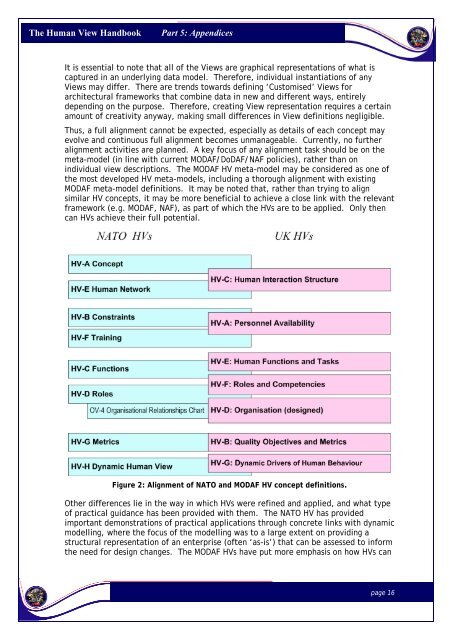The Human View Handbook for MODAF: Part V â Appendices
The Human View Handbook for MODAF: Part V â Appendices
The Human View Handbook for MODAF: Part V â Appendices
Create successful ePaper yourself
Turn your PDF publications into a flip-book with our unique Google optimized e-Paper software.
<strong>The</strong> <strong>Human</strong> <strong>View</strong> <strong>Handbook</strong><br />
<strong>Part</strong> 5: <strong>Appendices</strong><br />
It is essential to note that all of the <strong>View</strong>s are graphical representations of what is<br />
captured in an underlying data model. <strong>The</strong>re<strong>for</strong>e, individual instantiations of any<br />
<strong>View</strong>s may differ. <strong>The</strong>re are trends towards defining ‘Customised’ <strong>View</strong>s <strong>for</strong><br />
architectural frameworks that combine data in new and different ways, entirely<br />
depending on the purpose. <strong>The</strong>re<strong>for</strong>e, creating <strong>View</strong> representation requires a certain<br />
amount of creativity anyway, making small differences in <strong>View</strong> definitions negligible.<br />
Thus, a full alignment cannot be expected, especially as details of each concept may<br />
evolve and continuous full alignment becomes unmanageable. Currently, no further<br />
alignment activities are planned. A key focus of any alignment task should be on the<br />
meta-model (in line with current <strong>MODAF</strong>/DoDAF/NAF policies), rather than on<br />
individual view descriptions. <strong>The</strong> <strong>MODAF</strong> HV meta-model may be considered as one of<br />
the most developed HV meta-models, including a thorough alignment with existing<br />
<strong>MODAF</strong> meta-model definitions. It may be noted that, rather than trying to align<br />
similar HV concepts, it may be more beneficial to achieve a close link with the relevant<br />
framework (e.g. <strong>MODAF</strong>, NAF), as part of which the HVs are to be applied. Only then<br />
can HVs achieve their full potential.<br />
Figure 2: Alignment of NATO and <strong>MODAF</strong> HV concept definitions.<br />
Other differences lie in the way in which HVs were refined and applied, and what type<br />
of practical guidance has been provided with them. <strong>The</strong> NATO HV has provided<br />
important demonstrations of practical applications through concrete links with dynamic<br />
modelling, where the focus of the modelling was to a large extent on providing a<br />
structural representation of an enterprise (often ‘as-is’) that can be assessed to in<strong>for</strong>m<br />
the need <strong>for</strong> design changes. <strong>The</strong> <strong>MODAF</strong> HVs have put more emphasis on how HVs can<br />
page 16
















